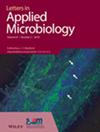组蛋白乙酰转移酶抑制剂(HATi)与槲皮素协同抑制热带念珠菌生物膜的形成
IF 2.1
4区 生物学
Q3 BIOTECHNOLOGY & APPLIED MICROBIOLOGY
引用次数: 0
摘要
组蛋白乙酰转移酶抑制剂(HATi)是一种基于机理的抑制剂,在治疗糖尿病、高脂血症、癌症和阿尔茨海默病等多种疾病方面前景看好。这项工作强调了 HATi 作为一种针对念珠菌生物膜的可能治疗策略的重要性。在本研究中,我们发现将 HATi、无患子酸和槲皮素(一种已知的类黄酮)结合使用,能显著阻止热带念珠菌生物膜的形成。我们还进一步发现,在联合使用的情况下,热带真菌的耐药基因(CDR1 和 MDR1)表达有相当程度的下调。此外,硅学研究显示,无患子酸(AA)与组蛋白乙酰转移酶 Rtt109 有强烈的相互作用,这可能是观察到的生物膜抑制作用的原因。总之,这项研究说明了如何利用 HATi 来增强植物活性物质或抗真菌药物对耐药酵母菌感染的抑制作用。本文章由计算机程序翻译,如有差异,请以英文原文为准。
Synergy of Histone Acetyltransferase Inhibitor (HATi) with Quercetin Inhibits Biofilm Formation in Candida tropicalis.
Histone acetyltransferase inhibitors (HATi) are mechanism-based inhibitors that show promise in the treatment of several illnesses, including diabetes, hyperlipidemia, cancer, and Alzheimer's disease. The work emphasizes the significance of HATi as a possible treatment strategy against Candida species biofilms. Here, in this study, we found that combining a HATi, anacardic acid, and quercetin, a known flavonoid, significantly prevented biofilm formation by C. tropicalis. We further show that C. tropicalis exhibited a considerable downregulation of drug-resistance gene expression (CDR1 and MDR1) when co-administrated. Additionally, in silico studies revealed that the anacardic acid (AA) interacts strongly with a histone acetyltransferase, Rtt109, which may account for the observed biofilm inhibitory effect. In conclusion, the study illustrates how HATi may be used to potentiate the inhibitory action of phytoactives or antifungals against drug-resistant yeast infections.
求助全文
通过发布文献求助,成功后即可免费获取论文全文。
去求助
来源期刊

Letters in Applied Microbiology
工程技术-生物工程与应用微生物
CiteScore
4.40
自引率
4.20%
发文量
225
审稿时长
3.3 months
期刊介绍:
Journal of & Letters in Applied Microbiology are two of the flagship research journals of the Society for Applied Microbiology (SfAM). For more than 75 years they have been publishing top quality research and reviews in the broad field of applied microbiology. The journals are provided to all SfAM members as well as having a global online readership totalling more than 500,000 downloads per year in more than 200 countries. Submitting authors can expect fast decision and publication times, averaging 33 days to first decision and 34 days from acceptance to online publication. There are no page charges.
 求助内容:
求助内容: 应助结果提醒方式:
应助结果提醒方式:


